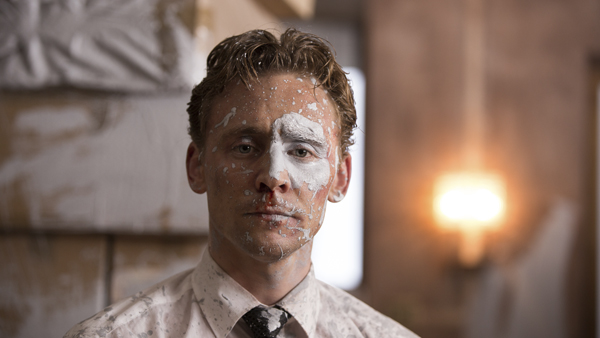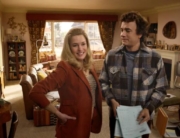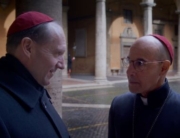Ben Wheatley is one of Britain’s most original contemporary directors. His genre experimentations includes Down Terrace, a domestic gangster movie, the crime/horror hybrid Kill List, the serial killer comedy of manners Sightseers, and A Field In England, a psychedelic trip into magic and madness during the English Civil War. His fifth feature, High-Rise, is his first adapted screenplay, based on the 1975 novel by J.G. Ballard. It has taken nearly 40 years, and multiple attempts, to translate Ballard’s darkly comic exploration of the middle classes to screen, and it’s the first major adaptation of his work since David Cronenberg’s Crash in 1996.
The eponymous skyscraper, the first of five to be completed, is a triumph of engineering that offers the promise of paradise to its expectant residents. Presided over by its architect, Anthony Royal (Jeremy Irons), from his top floor penthouse overlooking London, the newly erected, 40-story tower is his grand social experiment. One of the last to occupy a spacious bachelor pad on the 25th floor is Dr. Robert Laing (played with ironic detachment by Tom Hiddleston), an upwardly mobile, divorced physiologist starting anew. Confined to the second floor with his pregnant wife and children, documentary filmmaker Richard Wilder (Luke Evans), a gregarious womanizer, sleeps his way up the social ladder through the buildings endless round of parties.
But as the building’s infrastructure breaks down, grievances escalate and expose the tenants’ hierarchy. While social chameleon Laing navigates the emerging class conflict, Wilder agitates, leading factions to confront Royal and his coterie at the top. Amid orgiastic debauchery, intimidation, and violence, an ill-trained middle-class militia cast off their repressed instincts and organize themselves, floor against floor, to engage in open conflict. As Royal’s building descends into squalor and all-out war, no one imagines declaring a truce.
The adaptation by Wheatley and Amy Jump, his on- and offscreen partner, of Ballard’s dystopian predictive fiction maintains the bookend structure and Laing’s, Royal’s, and Wilder’s viewpoints. While the novel lacks a specific, character motivated and inciting incident, the screenplay embellishes, strengthening motives as well as elevating female roles.
Noticeably, this is a strikingly stylish film, Wheatley’s first with a sizable budget and big stars, including Sienna Miller and Elisabeth Moss. His gleeful satire maintains the novel’s 1970s futuristic world, opening with Laing devouring a dog in squalor on his balcony while observing in voice-over that he is “living in a future that had already taken place,” before the film flashes back to his first days in the building.
Wheatley heightens the tone of the book and the excesses: Royal’s wife, Anne (Keeley Hawes), masquerades as Marie Antoinette at their exclusive, French Revolution–themed party while her white horse grazes on the pastoral rooftop terrace. As primal urges prevail, Laing glides through the increasingly sinister parties and excess anaesthetizing his own guilt through drugs and booze. Neighbors video their violence and sexual liberation to screen them for each other’s pleasure, and as Wilder makes his ascent to the penthouse, fueled by alcohol, he obsessively films the decadence and despair, delighted that he has found the subject for his latest documentary.
Shot by Wheatley’s regular collaborator, cinematographer Laurie Rose, the production is a fusion of in-camera and CGI effects. Rose uses vintage lenses on digital cameras to recreate the period and combines tracking and crane shots with intense handheld close-ups and kaleidoscopic effects to intensify the tone. This coupled with the production design—the brutalist architecture and indulgent interiors—are reminiscent of Stanley Kubrick.
Clint Mansell’s inventive electronic score is hypnotic—erotic and disturbing. Abba’s pop tune “SOS” is given a makeover and jarringly interwoven, reworked by Mansell in upbeat strings and by the British trip-hop band Portishead into a bleak, foreboding version that shifts the film’s mood. However, at times the score is overwhelming and leaves no room to breathe. The driving music desensitizes the violence—particularly the sexual violence—where ambient sound could have been more effective.
In the final scene, Wheatley wears his politics on his sleeve. He nods to the future and the aggressive individualism that was ushered in by Margaret Thatcher’s Conservative government, whose policy of selling off social (affordable) housing for political gain has, in large part, led to the United Kingdom’s contemporary housing crisis. Recent attempts to address the housing shortage require compulsory “affordable housing” in private apartment blocks. As in the book, and the film, developers are allocating separate entrances for “lower class” tenants.
While the political subtext may not explicitly translate to an American audience, Ballard’s preoccupation with technology does. The resident’s documentation of their uninhibited abandon anticipates the wide-ranging narcissism of our digital age. Wheatley sustains the mayhem with gleeful indulgence that is both the subject and perhaps for some the flaw of the film.







Leave A Comment